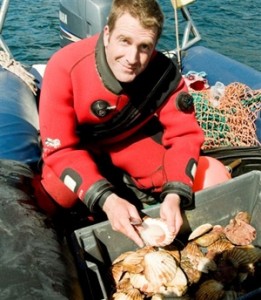I’ve just been looking at a very tempting recipe for hand-dived scallops with pea purée, beetroot jelly and pancetta foam on the BBC food web site.
No, keen reader, I’m not going to branch into a new career in cuisine just yet. But I’m concerned about sustainable fishing, and those two words “hand-dived” seem to seal the deal for me as far as this delectable bivalve is concerned.
We are seeing scallops more and more on menus. Their appeal to chefs is easy to understand: relatively simple to prepare, and a good professional challenge to match them with a range of ingredients.
But how many people who ask for scallops in a restaurant know how they are gathered? Not so many many, I suspect. Although that doesn’t mean they don’t care.
And while it is not easy for a restaurant to obtain fish from sustainable sources, and then proclaim the fact with confidence on the menu, with scallops the issue is relatively straightforward. It’s contained in those two words: “hand-dived”.
Here is the opportunity for restaurants to be very virtuous, while striking a blow for conservation, and without too much effort. If it doesn’t say on the menu that the scallops they serve are hand-dived (hand picked from the sea bottom by divers), the likelihood is they were dredged: throughout Europe scallops are mostly harvested by dredging And a very destructive process it is.
Scallops are rich in vitamin B12, calcium, iron and other minerals, magnesium, potassium, zinc and copper. They are also an excellent source of protein, phosphorus and selenium. On its website Seafood Devon and Dorset notes that UK waters are a source of very fine scallops and some of the best are found in SW Channel waters, with a growing market for hand-dived scallops, especially from shallow reef areas, such as in Lyme Bay and off Start Point.
Scallop fishermen and producers in SW inshore waters are involved such projects as Seabed Habitat Mapping, Finding Sanctuary and Fishermap, using monitoring equipment to ensure harvesting is restricted to existing scallop beds and does not impinge upon areas of delicate marine habitat. (There’s a taste argument against dredged scallops too. Wikipedia notes: “Dredge-harvesting methods often result in delays of up to two weeks before the scallops arrive at market, which can cause the flesh to break down, and results in a much shorter shelf life.”
One very conservationist minded fishermen, and a bright new prophet for this cause, is Guy Grieve, who writes a blog for fish2fork.com. He set up The Ethical Shellfish Company in 2010 with his wife Juliet from their home on the Isle of Mull. West of Scotland waters are also very good for the scallop.
His web site explains: “We have seen for ourselves the damage that is being done to the marine environment by fishing methods such as dredging and bottom trawling. Our divers ensure that only large and medium sized scallops are caught. We don’t take small scallops, leaving them to grow and breed. Equally, we don’t take extra large scallops, as these produce the most spawn, ensuring healthy stocks in the future. [And] Our divers gather scallops to order, ensuring that we don’t take more than we need.”
Of course hand-dived scallops will cost more. That’s how it has to be, But many chefs already have the message. Earlier this year the Restaurant Angelique opened in Dartmouth, Devon, with seared hand dived scallops with sag aloo and cauliflower carpaccio on the inaugural night. Now its up to the rest of us to refuse any scallop on the menu unless it has those magic words: hand-dived.

